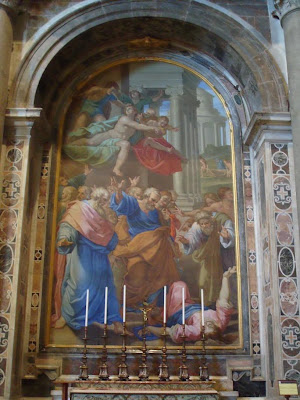
Today is the feast of St Catherine of Alexandria, the virgin martyr who famously was almost put to death on a wheel. When this method of execution (which gave us the term 'catherine wheel') failed, she was beheaded. The image above shows a statue of her on the reredos of the Cathedral's Sacred Heart altar. In the Middle Ages St Catherine was extremely popular, and it was on this feast in 1535 that St Angela Merici chose to found her company of religious women, which bears the name of another virgin martyr, St Ursula, who also enjoyed great popularity at the time. Angela founded her company in Brescia, Italy (more recently famous as the home town of Pope Paul VI) to enable women to live consecrated lives in their own homes and keeping their occupations. At a time when women were expected to choose between a husband or a cloistered life, it was a daring move! As the company required no dowry, it was open to women of all social backgrounds.

There are also two stained glass images of St Catherine in the Cathedral: this one (she is seen here on the left, holding the palm branch of martyrdom) in the Te Deum window, and one in the Whiteside Chantry (
see here). With today's feast and the anniversary of the foundation of the Ursulines, the order now begins its 475th year, a milestone which is particularly important to our parish, as we are currently served by three Ursuline sisters. Congratulations to them and to all the members of the Ursuline family; we will feature more on the Ursulines' anniversary later in the year progresses.
 Today is the feast of St Andrew, brother of our own patron St Peter and patron of - among others - Scotland, Russia and Greece. The pictures here were taken on the recent parish trip to Rome, and show the church of San Andrea della Valle. It wasn't on the list of churches visited by the group, but seems worth sharing today all the same. Built in a Baroque style similar to St Peter's Basilica, and with Rome's second largest church dome after the Vatican, it seems a fitting 'brother' to the basilica dedicated to St Peter.
Today is the feast of St Andrew, brother of our own patron St Peter and patron of - among others - Scotland, Russia and Greece. The pictures here were taken on the recent parish trip to Rome, and show the church of San Andrea della Valle. It wasn't on the list of churches visited by the group, but seems worth sharing today all the same. Built in a Baroque style similar to St Peter's Basilica, and with Rome's second largest church dome after the Vatican, it seems a fitting 'brother' to the basilica dedicated to St Peter. The large painting above the high altar shows the crucifixion of St Andrew, which according to tradition took place on an X-shaped cross. This, of course, is the origin of the shape of the Scottish flag.
The large painting above the high altar shows the crucifixion of St Andrew, which according to tradition took place on an X-shaped cross. This, of course, is the origin of the shape of the Scottish flag. Two large paintings to the left and right of it show him being lifted onto his cross...
Two large paintings to the left and right of it show him being lifted onto his cross... ... and him being taken down after his death. Aside from the tradition surrounding his death, much was written about his life and he is, of course, a prominent figure in the gospels. Although he is not mentioned frequently, he is important in that he is understood to be the first of the twelve apostles to follow the Lord, and even introduced his brother, Peter, to Jesus with the words, "We have found the Messiah" (John 1:41). In St John's account of the feeding of the 5000, it is St Andrew who brings the loaves and fish to Jesus (John 6:8-9). Visiting Scotland in 1982, Pope John Paul II made reference to this incident, saying that it teaches us to bring our gifts, however small, to the service of God, and allow Him to do the rest.
... and him being taken down after his death. Aside from the tradition surrounding his death, much was written about his life and he is, of course, a prominent figure in the gospels. Although he is not mentioned frequently, he is important in that he is understood to be the first of the twelve apostles to follow the Lord, and even introduced his brother, Peter, to Jesus with the words, "We have found the Messiah" (John 1:41). In St John's account of the feeding of the 5000, it is St Andrew who brings the loaves and fish to Jesus (John 6:8-9). Visiting Scotland in 1982, Pope John Paul II made reference to this incident, saying that it teaches us to bring our gifts, however small, to the service of God, and allow Him to do the rest.





















































